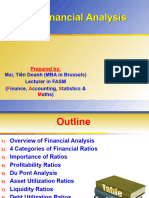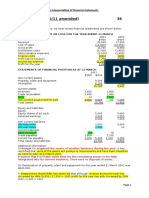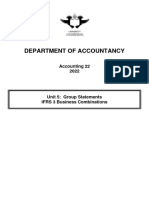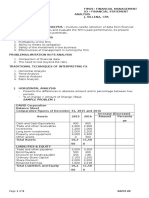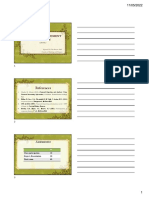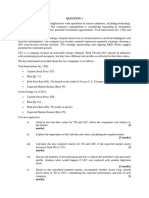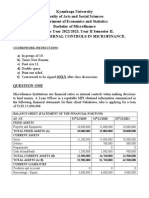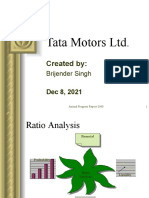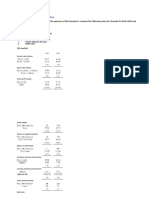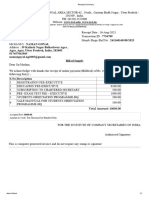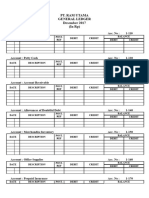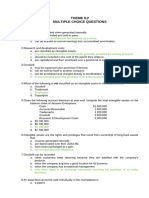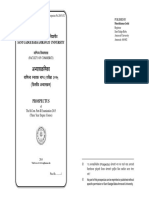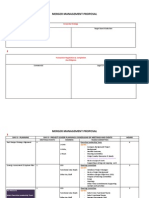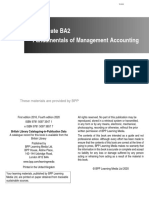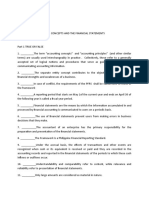0 ratings0% found this document useful (0 votes)
16 viewsBlock 12ce PPT Ch03 Final
Block 12ce PPT Ch03 Final
Uploaded by
nimugiritshaThis document provides an outline and content for a chapter on financial analysis. It defines financial analysis and outlines 4 categories of financial ratios - profitability, asset utilization, liquidity, and debt utilization. It then provides examples of 13 common financial ratios calculated for a sample company and compares them to industry averages. The chapter also explains DuPont analysis and how it can decompose return on assets and equity.
Copyright:
© All Rights Reserved
Available Formats
Download as PPTX, PDF, TXT or read online from Scribd
Block 12ce PPT Ch03 Final
Block 12ce PPT Ch03 Final
Uploaded by
nimugiritsha0 ratings0% found this document useful (0 votes)
16 views33 pagesThis document provides an outline and content for a chapter on financial analysis. It defines financial analysis and outlines 4 categories of financial ratios - profitability, asset utilization, liquidity, and debt utilization. It then provides examples of 13 common financial ratios calculated for a sample company and compares them to industry averages. The chapter also explains DuPont analysis and how it can decompose return on assets and equity.
Original Title
Block 12ce Ppt Ch03 Final
Copyright
© © All Rights Reserved
Available Formats
PPTX, PDF, TXT or read online from Scribd
Share this document
Did you find this document useful?
Is this content inappropriate?
This document provides an outline and content for a chapter on financial analysis. It defines financial analysis and outlines 4 categories of financial ratios - profitability, asset utilization, liquidity, and debt utilization. It then provides examples of 13 common financial ratios calculated for a sample company and compares them to industry averages. The chapter also explains DuPont analysis and how it can decompose return on assets and equity.
Copyright:
© All Rights Reserved
Available Formats
Download as PPTX, PDF, TXT or read online from Scribd
Download as pptx, pdf, or txt
0 ratings0% found this document useful (0 votes)
16 views33 pagesBlock 12ce PPT Ch03 Final
Block 12ce PPT Ch03 Final
Uploaded by
nimugiritshaThis document provides an outline and content for a chapter on financial analysis. It defines financial analysis and outlines 4 categories of financial ratios - profitability, asset utilization, liquidity, and debt utilization. It then provides examples of 13 common financial ratios calculated for a sample company and compares them to industry averages. The chapter also explains DuPont analysis and how it can decompose return on assets and equity.
Copyright:
© All Rights Reserved
Available Formats
Download as PPTX, PDF, TXT or read online from Scribd
Download as pptx, pdf, or txt
You are on page 1of 33
CHAPTER
3
Financial Analysis
Microsoft® PowerPoint® Presentation
Prepared by Kathy Faber, Conestoga College
© 2021 MCGRAW HILL 1
What is Financial Analysis?
4 Categories of Financial Ratios
Chapter 3
Outline Techniques of Ratio Analysis
Distortion in Financial Reporting
Summary and Conclusions
© 2021 MCGRAW HILL 2
Learning Objectives
• Calculate 13 financial ratios that
Calculate measure profitability, asset utilization,
liquidity and debt utilization. (LO1)
• Assess a company’s source of
Assess profitability using the DuPont system
of analysis. (LO2)
Examine
• Examine the ratios in comparison to
industry averages. (LO3)
© 2021 MCGRAW HILL 3
Learning Objectives
• Examine the ratios and company
Examine performance by means of trend
analysis. (LO4)
Interpret
• Interpret ratios and identify corrective
action for abnormal results. (LO4)
Identify
• Identify sources of distortion in
reported income. (LO5)
© 2021 MCGRAW HILL 4
Evaluating a firm’s financial
performance
What is Calculating ratios to reveal
Financial relationships between different
Analysis? accounts of financial statements
Linking ratios to reveal the
factors determining a firm’s
profitability and value
Financial analysis may not
answer questions, but leads to
further inquiry
© 2021 MCGRAW HILL 5
A. Profitability Ratios
Classification
System of B. Asset Utilization Ratios
Financial
Ratios C. Liquidity Ratios
D. Debt Utilization Ratios
© 2021 MCGRAW HILL 6
Show how profitable a
company is
# Formula
1a Profit margin
A. 1b Gross profit margin
Profitability 2 Return on assets (ROA)
(investment)
Ratios 3 Return on equity (ROE)
(common shareholders)
© 2021 MCGRAW HILL 7
Show how effectively a company
uses its assets
# Formula
4a Receivable turnover
B. Asset 4b Average collection period (day’s
sales outstanding)
Utilization 5a Inventory turnover
Ratios 5b Inventory holding period
6a Accounts payable turnover
6b Accounts payable period
7 Capital asset turnover
8 Total asset turnover
© 2021 MCGRAW HILL 8
Show how liquid a company is
or how much cash it has
available to meet short-term
needs.
# Formula
C. Liquidity 9 Current ratio
Ratios 10 Quick ratio (acid test)
© 2021 MCGRAW HILL 9
Show how well a company is
managing or using debt.
# Formula
11 Debt to total assets
D. Debt 12 Times interest earned
13 Fixed charge coverage
Utilization
Ratios
© 2021 MCGRAW HILL 10
SAXTON COMPANY
Income Statement
For the Year 20XX
Sales $4,000,000
Table 3-1 Cost of goods sold 3,000,000
Gross profit 1,000,000
Non-IFRS Selling and administrative expense* 450,000
financial Operating profit 550,000
statements for Interest expense 50,000
ratio analysis of Extraordinary loss 100,000
private Net income before taxes 400,000
companies Taxes (50%) 200,000
Net income $ 200,000
*Includes $50,000 lease payments
© 2021 MCGRAW HILL 11
SAXTON COMPANY
Balance Sheet
As of December 31, 20XX
Assets
Cash $ 30,000
Marketable securities 50,000
Accounts receivable 350,000
Inventory 370,000
Table 3-1 Total current assets 800,000
Non-IFRS Net plant and equipment 800,000
financial Total assets $1,600,000
statements for Liabilities and Shareholders’ Equity
ratio analysis of Accounts payable $50,000
private companies Notes payable 250,000
– Part 2 Total current liabilities 300,000
Long-term liabilities 300,000
Total liabilities 600,000
Common stock 400,000
Retained earnings 600,000
Total liabilities and shareholders’ equity $1,600,000
© 2021 MCGRAW HILL 12
Profitability Ratios – Part 1
Industry
Ratio Formula Saxton Company
Average
(3-1a)
Profit margin = X 100% = X 100% = 5% 6.5%
(3-1b)
Gross profit = X 100% = X 100% = 25% 22%
margin
(3-2a)
Return on = X 100% = X 100% = 12.5% 9.75%
Assets (ROA)
(3-2b) 6.5% X 1.5
Return on = X = 5% X X 100% = 12.5%
Assets (ROA) = 9.75%
© 2021 MCGRAW HILL 13
Profitability Ratios – Part 2
Industry
Ratio Formula Saxton Company
Average
(3-3a)
Return on = X 100% = X 100% = 20% 15%
equity (ROE)
(3-3b)
Equity = = = 1.6 times 1.5 times
multiplier
(3-3c) Return
on equity = ROA X Equity multiplier = 12.5% X 1.6 times = 20% 15%
(ROE)
© 2021 MCGRAW HILL 14
Reveals the relationships
between profitability ratios and
asset utilization ratios and debt
utilization ratios
DuPont
Analysis Decomposes Return on Asset
(ROA) into two factors:
ROA =
= X
= Profit Margin X Asset Turnover
© 2021 MCGRAW HILL 15
Decomposes Return on Equity (ROE)
into three factors:
ROE =
DuPont
Analysis – = X X
Part 2 = Profit Margin X Asset Turnover X Equity Multiplier
ROE = ROA X Equity Multiplier
© 2021 MCGRAW HILL 16
Figure 3-1
DuPont analysis
© 2021 MCGRAW HILL 17
Finance in Action
Applying DuPont Analysis
© 2021 MCGRAW HILL 18
Asset Utilization Ratios - Receviables
Industry
Ratio Formula Saxton Company
Average
(3-4a)
Receivables = = = 11.4 times 10 times
turnover
(3-4b)
Average
collection = = = 32 days 36 days
period
© 2021 MCGRAW HILL 19
Asset Utilization Ratios – Inventory
Industry
Ratio Formula Saxton Company
Average
(3-5a)
Inventory = = = 8.1 times 7 times
turnover
(3-5b)
Inventory
holding = = = 45 days 52 days
period
© 2021 MCGRAW HILL 20
Asset Utilization Ratios – Payables
Industry
Ratio Formula Saxton Company
Average
(3-6a)
Accounts
payable = = = 60.0 times 12 times
turnover
(3-6b)
Accounts
payable = = = 6 days 30 days
period
© 2021 MCGRAW HILL 21
Asset Utilization Ratios – Assets
Industry
Ratio Formula Saxton Company
Average
(3-7)
Capital
asset = = = 5.0 times 5.4 times
turnover
(3-8)
Total asset = = = 2.5 times 1.5 times
turnover
© 2021 MCGRAW HILL 22
Liquidity Ratios
Industry
Ratio Formula Saxton Company
Average
(3-9)
Current = = = 2.67:1 2.1:1
ratio
(3-10)
Quick ratio = = = 1.43:1 1.0:1
© 2021 MCGRAW HILL 23
Debt Utilization Ratios
Industry
Ratio Formula Saxton Company
Average
(3-11)
Debt to
total = X 100% = X 100% = 37.5% 33%
assets
(3-12)
Times
interest = = = 11 times 7 times
earned
(3-13)
Fixed
charge = = = 6 times 5.5 times
coverage
© 2021 MCGRAW HILL 24
Table 3-2 Ratio analysis
Saxton Industry
Company Average Conclusion
A. Profitability
1a. Profit margin 5.0% 6.5% Below average
1b. Gross margin 25.0% 28.0% Below average
2. Return on assets 12.5% 10.0% Above average due to high turnover
3. Return on equity 20.0% 15.0% Good due to ratios 2 and 11
B. Asset Utilization
4a. Receivable turnover 11.4 10.0 Good
4b. Average collection period 32 36 Good
5a. Inventory turnover 8.1 7.0 Good
5b. Inventory holding period 45 52 Good
6a. Accounts payable turnover 60.0 12.0 Poor
7. Capital asset turnover 5.0 5.4 Below average
8. Total asset turnover 2.5 1.5 Good
© 2021 MCGRAW HILL 25
Table 3-2 Ratio analysis – Part 2
Saxton Industry
Company Average Conclusion
C. Liquidity
9. Current ratio 2.67 2.1 Good
10. Quick ratio 1.43 1.0 Good
D. Debt Utilization
11. Debt to total assets 37.5% 33.0% Slightly more debt, but reasonable
12. Times interest earned 11 7 Good
13. Fixed charge coverage 6 5.5 Good
© 2021 MCGRAW HILL 26
Comparing a company’s ratios to the
industry average or industry leader
may not be appropriate.
Interpretation Over the course of the business cycle,
of Ratios by because of sales and profit fluctuations,
yearly ratio analysis may not present an
Trend accurate picture.
Analysis
Comparing the same company’s ratios
on a year-to-year basis is trend analysis
and may reveal whether ratios are
improving or worsening over the length
of a longer time cycle.
© 2021 MCGRAW HILL 27
Figure 3-2
Trend analysis
© 2021 MCGRAW HILL 28
Bank of Montreal Royal Bank
Year ROA ROE ROA ROE
2006 0.83% 17.7% 0.88% 21.4%
2008 0.50 13.0 0.63 18.1
2010 0.44 14.9 0.58 13.2
2012 0.69 15.9 0.86 18.25
2014 0.96 14.9 0.97 19.5
2016 0.64 10.4 0.79 13.1
2019 0.84 14.06 1.04 17.4
Table 3-3
Trend analysis of competitors
© 2021 MCGRAW HILL 29
Historical-based accounting in
an environment of changing
prices may distort financial
results:
immediate effect of price changes
(inflation/disinflation) on revenues
Distortion in versus delayed impact on asset
Financial values
Reporting Accrual-based accounting allows
certain leeway in matching the
revenues and expenses
cost of goods sold (LIFO vs. FIFO)
asset write-downs
net income
© 2021 MCGRAW HILL 30
Table 3-7
Income Statement
Income Statement For the Year 20XY
Conservative High Reported
(A) Income (B)
Sales $4,000,000 $4,200,000
Cost of goods sold 3,000,000 2,400,000
Gross profit 1,000,000 1,800,000
Selling and administrative expense 450,000 450,000
Operating profit 550,000 1,350,000
Interest expense 50,000 50,000
Net income before taxes 500,000 1,300,000
Taxes (40%) 200,000 520,000
Net income 300,000 780,000
Extraordinary loss (net of tax) 60,000 0
Net income transferred to retained earnings $ 240,000 $ 780,000
© 2021 MCGRAW HILL 31
Financial ratios cover 4 areas of
management: profitability, asset
utilization, liquidity and debt
utilization.
The DuPont system of analysis
Summary and tells us that the profit margin,
Conclusions asset turnover, and debt usage
each contributes to return on
equity.
Ratios should be compared to
industry average (comparative
analysis) as well as historical data
(trend analysis).
© 2021 MCGRAW HILL 32
What ratios do is to suggest
aspects requiring further
exploration. It is the
Summary and manager/analyst’s job to answer
Conclusions – the questions revealed by ratios.
Part 2
Analysts should also be aware of
the distortion in financial
reporting.
© 2021 MCGRAW HILL 33
You might also like
- Essentials of Financial Management 3 Edition-Page 134 4-24 Ratio AnalysisDocument3 pagesEssentials of Financial Management 3 Edition-Page 134 4-24 Ratio AnalysisNHIMALN A/L KUMAR -100% (2)
- Level 3 - Synoptic - Question BankDocument416 pagesLevel 3 - Synoptic - Question BanktrueNo ratings yet
- SAP FI - Asset AccountingDocument27 pagesSAP FI - Asset AccountingAmit Sathe100% (1)
- Signal Cable Company: Cash Flow AnalysisDocument4 pagesSignal Cable Company: Cash Flow AnalysisRauf JaferiNo ratings yet
- Financial Statement AnalysisDocument82 pagesFinancial Statement AnalysisHeisen LukeNo ratings yet
- Chapter 3 Lecture NotesDocument11 pagesChapter 3 Lecture Notesmarandeep kosNo ratings yet
- Block 12ce PPT Ch02 FinalDocument53 pagesBlock 12ce PPT Ch02 FinalnimugiritshaNo ratings yet
- PPT CH05 Operating Financial Leverage 96e5268e696ef1d2b9155d64491608a0Document34 pagesPPT CH05 Operating Financial Leverage 96e5268e696ef1d2b9155d64491608a0Rohitcool535No ratings yet
- Chapter 2Document29 pagesChapter 2ha thong thuongNo ratings yet
- AFA Tut11 Anaylsis & Interpretation of FSDocument9 pagesAFA Tut11 Anaylsis & Interpretation of FSJIA HUI LIMNo ratings yet
- Bodie10ce SM CH19Document12 pagesBodie10ce SM CH19beadand1No ratings yet
- Module 3-Ratio AnalysisDocument8 pagesModule 3-Ratio Analysisjoelmanoj98No ratings yet
- Block 11ce PPT CH03 FINALDocument31 pagesBlock 11ce PPT CH03 FINALmk688355No ratings yet
- Solutions Manual: Accounting: Building Business SkillsDocument31 pagesSolutions Manual: Accounting: Building Business SkillsNicole HungNo ratings yet
- ASAL Business Coursebook Answers PDF 23Document10 pagesASAL Business Coursebook Answers PDF 23HanNo ratings yet
- Unit 5-Group Statements L IFRS 3 Business Combinations (2024)Document9 pagesUnit 5-Group Statements L IFRS 3 Business Combinations (2024)jamileethomNo ratings yet
- Ans File HI5002Document16 pagesAns File HI5002haafiNo ratings yet
- Brewer7ce PPT Ch13Document46 pagesBrewer7ce PPT Ch13jenishrathod555No ratings yet
- Chapter 3Document73 pagesChapter 3Mark Arceo50% (2)
- Fim01 - Fs AnalysisDocument8 pagesFim01 - Fs AnalysisJomar VillenaNo ratings yet
- MBM633, QB, Unit-4, 5Document4 pagesMBM633, QB, Unit-4, 5Mayank bhardwajNo ratings yet
- Accounting For Reporting Companies Marking GuideDocument12 pagesAccounting For Reporting Companies Marking Guideangelbert mazendaNo ratings yet
- Mba ZC415 Ec-3r First Sem 2022-2023Document4 pagesMba ZC415 Ec-3r First Sem 2022-2023Ravi KaviNo ratings yet
- Making Capital Investment DecisionsDocument25 pagesMaking Capital Investment DecisionsLay TekchhayNo ratings yet
- Accounting Grade 12 Term 2 Task 3 Project - QP & ABDocument10 pagesAccounting Grade 12 Term 2 Task 3 Project - QP & ABzaferismailasvat1786No ratings yet
- Financial Accounting: Tools For Business Decision Making: Ninth EditionDocument86 pagesFinancial Accounting: Tools For Business Decision Making: Ninth EditionJesussNo ratings yet
- Chapter 1 Introduction To FSADocument11 pagesChapter 1 Introduction To FSALuu Nhat MinhNo ratings yet
- MGMT - Financial Management - ExamDocument4 pagesMGMT - Financial Management - ExamjustinNo ratings yet
- Graduate School: AnswerDocument3 pagesGraduate School: AnswerIan Mark Loreto RemanesNo ratings yet
- ACC501_ Assignment No.1Document4 pagesACC501_ Assignment No.1ahsan sajjadNo ratings yet
- Illustration 1 & 2Document5 pagesIllustration 1 & 2faith olaNo ratings yet
- FM Ii Case 4 Group 5Document8 pagesFM Ii Case 4 Group 5AntonNo ratings yet
- Acc 2021 T1 Week 7 Ratios Audit Governance ENG MEMODocument4 pagesAcc 2021 T1 Week 7 Ratios Audit Governance ENG MEMOnqobilemosia592No ratings yet
- Profitability Ratio AnalysisDocument7 pagesProfitability Ratio AnalysisJonathan Alexi Molina RoaNo ratings yet
- Internal Controls in MicrofinanceDocument10 pagesInternal Controls in Microfinancemugenyi DixonNo ratings yet
- 130565353X 540322Document19 pages130565353X 540322blackghostNo ratings yet
- Questions_28089102_2024_01_22_16_52Document2 pagesQuestions_28089102_2024_01_22_16_52satyamsahni005No ratings yet
- Chapter Two HandoutDocument24 pagesChapter Two HandoutNati AlexNo ratings yet
- 2424 Accounting GR10 Term 3 Controlled Test - QPDocument10 pages2424 Accounting GR10 Term 3 Controlled Test - QPmfundomngomezulu8No ratings yet
- Exercise Ni ValewDocument4 pagesExercise Ni ValewALMA MORENANo ratings yet
- Assignment 1 Brief GuidelinesDocument3 pagesAssignment 1 Brief GuidelinesBanda SamsonNo ratings yet
- Unit 2 Financial AnalysisDocument12 pagesUnit 2 Financial AnalysisGizaw BelayNo ratings yet
- Tata Motors LTD.: Created byDocument32 pagesTata Motors LTD.: Created byBrijender SinghNo ratings yet
- Week 6 - Introduction To Financial Statement AnalysisDocument23 pagesWeek 6 - Introduction To Financial Statement AnalysisObed Darko BaahNo ratings yet
- The Examiner's Answers F2 - Financial Management March 2013: Section ADocument18 pagesThe Examiner's Answers F2 - Financial Management March 2013: Section Amd salehinNo ratings yet
- Chapter 03 - Ratio - NEWDocument20 pagesChapter 03 - Ratio - NEWChinmoy DasNo ratings yet
- ACCT10002 Tutorial 1 Exercises, 2020 SM1Document5 pagesACCT10002 Tutorial 1 Exercises, 2020 SM1JING NIENo ratings yet
- FS and Ratios Addtl ExercisesDocument5 pagesFS and Ratios Addtl ExercisesRaniel PamatmatNo ratings yet
- Handout 7 - Business FinanceDocument3 pagesHandout 7 - Business FinanceCeage SJNo ratings yet
- Working Wit H Financ Ial State Me NtsDocument44 pagesWorking Wit H Financ Ial State Me NtsQuang NguyễnNo ratings yet
- Faculty of Commerce and Law B C (H) : Achelor OF Ommerce OnoursDocument4 pagesFaculty of Commerce and Law B C (H) : Achelor OF Ommerce OnourschagumukarobbieNo ratings yet
- PG Dip Man - Fin Man - Jan 2018 ExamDocument5 pagesPG Dip Man - Fin Man - Jan 2018 Examolwethu.mtyobile5No ratings yet
- FSA Tutorial 1Document2 pagesFSA Tutorial 1KHOO TAT SHERN DEXTONNo ratings yet
- 2003 DecemberDocument7 pages2003 DecemberSherif AwadNo ratings yet
- Module 10 BAEN 1 Principles of Accounting BSBADocument13 pagesModule 10 BAEN 1 Principles of Accounting BSBARyan Joseph GoNo ratings yet
- LATIHAN4 CFM Imam SartonoDocument10 pagesLATIHAN4 CFM Imam Sartonoims.mercubuanaNo ratings yet
- FM Handout 5Document32 pagesFM Handout 5Rofiq VedcNo ratings yet
- Alam PLC RajuDocument18 pagesAlam PLC RajurajuNo ratings yet
- FM Chapter 2Document16 pagesFM Chapter 2mearghaile4No ratings yet
- Question 27+28 AssignmentDocument2 pagesQuestion 27+28 AssignmentAnonymous GDOULL9No ratings yet
- How to Read a Financial Report: Wringing Vital Signs Out of the NumbersFrom EverandHow to Read a Financial Report: Wringing Vital Signs Out of the NumbersNo ratings yet
- Private Debt: Yield, Safety and the Emergence of Alternative LendingFrom EverandPrivate Debt: Yield, Safety and the Emergence of Alternative LendingNo ratings yet
- Chapter 3Document89 pagesChapter 3Nancy Mohamed Mahmoud AhmedNo ratings yet
- Cs Executive ReceiptDocument1 pageCs Executive Receiptnamangoyal.ng2005No ratings yet
- Chapter No. - 4 Forensic Accounting & Auditing - Scope & ProcessDocument44 pagesChapter No. - 4 Forensic Accounting & Auditing - Scope & ProcessDINGDINGWALANo ratings yet
- (Ebooks PDF) Download (Ebook PDF) Auditing and Assurance Services Global Edition 16th Full ChaptersDocument41 pages(Ebooks PDF) Download (Ebook PDF) Auditing and Assurance Services Global Edition 16th Full Chapterskronihardit90100% (3)
- Sir Dave's Classroom Quiz Bee Number 3 QuestionsDocument13 pagesSir Dave's Classroom Quiz Bee Number 3 QuestionsKenzel lawasNo ratings yet
- EVA ProblemDocument1 pageEVA ProblemAshutosh BiswalNo ratings yet
- GR 9 EMS P1 (English) November 2022 Possible AnswersDocument8 pagesGR 9 EMS P1 (English) November 2022 Possible Answerssamanthamachingura45No ratings yet
- Salce Prelim Act102 E2Document8 pagesSalce Prelim Act102 E2Joshua P. SalceNo ratings yet
- Our Lady of Fatima Academy of Davao, Inc.: Fatima ST., Brgy. 24-C Davao City S.Y. 2021 - 2022Document10 pagesOur Lady of Fatima Academy of Davao, Inc.: Fatima ST., Brgy. 24-C Davao City S.Y. 2021 - 2022Ever BrandinoNo ratings yet
- Financial Accounting III SyllabusDocument11 pagesFinancial Accounting III SyllabusMJ BotorNo ratings yet
- Strategic Cost Management - Semester SummaryDocument15 pagesStrategic Cost Management - Semester SummaryivandimaunahannnNo ratings yet
- Jad Payroll April 01-07 2022Document9 pagesJad Payroll April 01-07 2022Jervie JalaNo ratings yet
- Materi CPM Dan Contoh SoalDocument77 pagesMateri CPM Dan Contoh SoalNurlaila Rhaenita PutriNo ratings yet
- Pt. Ram Lembar Kerja (Sesi 2)Document10 pagesPt. Ram Lembar Kerja (Sesi 2)fannysuwandiNo ratings yet
- Task 2Document2 pagesTask 2Валерія ШикутаNo ratings yet
- 100 Solved MCQs of Financial AccountingDocument20 pages100 Solved MCQs of Financial Accountingburhan_qureshi77% (211)
- 25 Surbhi Bansal Audit Notes For IpccDocument161 pages25 Surbhi Bansal Audit Notes For IpccNavneet Kumar60% (5)
- Chapter 1 Garrison 13eDocument66 pagesChapter 1 Garrison 13efarhan MomenNo ratings yet
- Kieso IFRS4 TB ch10Document85 pagesKieso IFRS4 TB ch103ooobd1234No ratings yet
- I M B M +® Æ I " T ( "' : H V™ T JDocument26 pagesI M B M +® Æ I " T ( "' : H V™ T JPratik GazalwarNo ratings yet
- Financial Analysis Module - For Use With 3 Years DataDocument11 pagesFinancial Analysis Module - For Use With 3 Years DataYasser MaamounNo ratings yet
- Merger Management TemplateDocument7 pagesMerger Management TemplateAdrian KeysNo ratings yet
- CA Akash Shukla: Curriculum VitaeDocument3 pagesCA Akash Shukla: Curriculum VitaeThe Cultural CommitteeNo ratings yet
- Jawaban P11-4Document3 pagesJawaban P11-4nurlaeliyahrahayuNo ratings yet
- Assignment 1 - Nur Najihah Binti Rejalei (Acc407 - Ba2321a)Document5 pagesAssignment 1 - Nur Najihah Binti Rejalei (Acc407 - Ba2321a)Cik BeranganNo ratings yet
- CIMA Pass CardsDocument144 pagesCIMA Pass Cardsmonika PeterNo ratings yet
- DOH V CanchelaDocument2 pagesDOH V CanchelaEdith OliverosNo ratings yet
- Assignment 2 Accounting PrinciplesDocument5 pagesAssignment 2 Accounting PrinciplesFelipe Mensorado GrandeNo ratings yet








